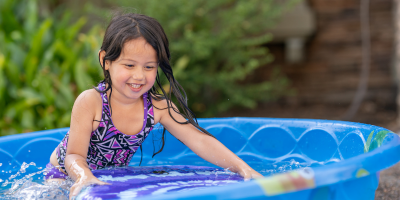A couple of months ago I heard from Liz Simpson about this fabulous sensory garden she was designing. I had no idea what a sensory garden was, but the more she explained it, the more I wanted her to be able to share it with you today. Check out her fun printable worksheets she’s designed to keep you on track with this project! – Sarah
Liz Simpson lives in Arizona with four children and chihuahua. Three of her four children have unique special needs which have allowed her to explore different methods of parenting and therapy styles with the help of professionals, friends, and other fellow parents. She is passionate about homeschooling, crafting, teaching Sunday school, and mentoring other parents in the early stages of managing learning, behavioral, or developmental challenges related to their kids. Connect with Liz on Pinterest and see even more Sensory Garden ideas.
Create Your Own Sensory Garden
Have you always wanted to make a creative, beautiful sensory garden but didn’t know how or where to start? Are you still sitting there wondering ‘what IS a sensory garden?’ Today we will make sense out of this fabulous new feature you are considering adding to your life.
What is a Sensory Garden?
A sensory garden is simply what it sounds like: a garden meant to delight one’s senses. If the garden area pleases and nurtures sight, sound, touch, scent, and yes, even taste, then it’s doing what it’s intended to. These spaces are therapeutic for those struggling with sensory processing disorders, depression, hormonal imbalances, fatigue, weight disorders, and more. Sensory gardens are also a great way to encourage children to explore, appreciate, and care for nature.
I have four children between the ages of four and eleven. Two of my children struggle with sensory integration dysfunction unrelated to autism. Due to that, I began researching ways to assist my children in having sensory experiences that are gradual and calming, while at the same time exposing them to things they might normally find obstructive to their learning and coping environments. For people who do not suffer from sensory integration dysfunction, this exposure is still beneficial as it prevents the development of aversions or negative associations due to various textures, visual stimuli, sounds, and smells.
The benefits are endless and I highly recommend creating your own.
As we did, you can choose to incorporate vegetables, herbs, and fruits into your garden and use them in your meals as well.
You do not need a 150-page book to develop a beneficial sensory garden, although there are plenty out there. Instead, follow along and I will help you create a fun, delightful space for your family, coworkers, or friends.
Step 1: Pick your location
You can place your sensory garden in almost any space available to you. Some places for consideration may include:
- A Backyard Space
- An Apartment Porch in Containers (Be creative! Gardens are not limited to big yard spaces.)
- An Office Break Room in Window Box Containers
- Elementary and Secondary Classrooms
- Playgrounds
Step 2: Clear Your Path
After you have decided the location of your garden, you will need to determine if your space will require weeding and rototilling, or simply a few pots filled with soil.
Prep your space by filling your pots, weeding and rototilling, adding a fresh layer of topsoil, and making sure your area is ready to add plants and planned features.
Step 3: Measure your space and map your garden area
Collect the measurements of the space you are using for your garden. For pots, keep in mind, you will want to measure length times width times depth (L x W x D). Then, use the measurements to create a map or drawing of your envisioned space. (If you are using pots, I suggest you also measure the area surrounding your pots – height, depth, and width for decor or water feature arrangements.)
Download the free printable worksheets here to help keep you on track!
Remember, the more detailed you are in your measurements, the more fun you will have. It truly is a headache to head out to the store, find a variety of things you are excited about including in your new space and then return home to find that a number of those items will not be successful due to your poor planning.
Things to consider placing on your map:
- location of outdoor water spigots if applicable (will help with placement for water features)
- fences or gates
- lighted vs. shaded areas
- outlets (if applicable for indoor/outdoor water features, wind features, etc.)
For outdoor gardeners, keep in mind that not all senses will be met through the garden itself. A few birdhouses or a birdbath that will attract the songbirds and their flapping, colorful wings will bring a lot of sensual delight to those enjoying your garden space (as well as to God’s beautiful creatures). Perhaps your children can help you build and paint your birdhouses. Using a protective outdoor spray coating to finish these projects will help them last in the weather nicely.
Finally, include on your map any areas you feel may need a fence or barrier to keep out animals or protect your garden from small toddlers or help stabilize it (if in an office space, etc.). These reminders are all very helpful when you are putting your materials together. If you are anything like me, you will forget these more mundane things while you are out looking at the “shiny” plants to buy.
Now that we know how much room we have and what kind of things we want to put where it’s time to…
Step 4: Go Shopping
I love to shop, so this is my favorite part! Taking in hand your shopping guide and measurements list (download a free one here), start to look through the list of items that you feel may inspire and nurture those who will be enjoying the garden space.
*Tip: If children are helping you create the space, ensure that they are taught, prior to entering the greenhouse, that looking and smelling are appropriate but touching is reserved for only the plants we are sure we are going to buy.
When you have decided on an item, let them help you gently place it in the cart.
Using the list as a guideline, you can ask yourself, is what I am adding to my garden meeting more than one of the sensory objectives? Is the water fixture friendly enough for someone to enjoy the sound but also dip their fingers in it? Is my lettuce patch too consistent or have I added a variation of lettuce to allow for visual stimulation from the different color and leaf patterns?
Taste. Touch. Smell. Sight. Sound.
Am I meeting three of these sensory needs through this feature?
Don’t forget to pick up any fencing you marked out on your map. See, aren’t we glad we measured and marked? I almost forgot, too.
I live in Arizona, so I will also make sure to grab a couple of bags of corn, peas, and sunflowers seeds for the garden as well. My kids love to watch things grow and help water from little cans, and it’s also an excellent sensory experience for them to dig holes in the dirt to plant (no gloves allowed!).
Whew! I don’t know about you, but it doesn’t take long to fill my cart! By this point, I can smell the lavender and my kids are running their fingers through the chimes. We are ready to go!
Step 5: Place and plant!
That’s it! You had your area mapped, you purchased what you wanted to go in the designated areas and now it’s time to fill the space with the fun new things you purchased.
Don’t forget to water and allow a lot of time to watch it come to life. Encourage your children to finger through the live plants and place your own nose deep into what you can.
Budget-Friendly Alternatives
Of course, if you can’t afford to go out and purchase everything new and still stick with the budget, use what you have around the house. Find old garden pots, paint leftover fence boards from an old project, and divide/relocate plants you already have. Use seeds whenever possible and simply have fun with it. Keep in mind that it doesn’t have to happen all at once. Many people build their sensory gardens over several years, adapting as their children get older and their financial situations change. Don’t stress about the details, just get out there and have fun experiencing all of the senses in nature.
Happy gardening!
Liz
Tip: Even if you aren’t putting that sensory garden together at this moment, why not grab the shopping lists so you are prepared for the future. You can find them HERE.



